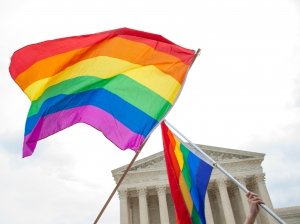Historic Supreme Court Opinion Affirms Protections for LGBT Workers
June 16th, 2020
 On June 15, 2020, the U.S. Supreme Court ruled that Title VII’s prohibitions against discrimination on the basis of sex also prohibit an employer from discriminating against an employee because of their sexual orientation or transgender status.
On June 15, 2020, the U.S. Supreme Court ruled that Title VII’s prohibitions against discrimination on the basis of sex also prohibit an employer from discriminating against an employee because of their sexual orientation or transgender status.
Prior to the Supreme Court’s landmark ruling, only 21 states and the District of Columbia, Guam, and Puerto Rico had statutes that protected both sexual orientation and gender identity in the employment sector – meaning approximately 52% of the country’s LGBT population did not have any protections in the workplace, and could be legally terminated without recourse for no other reason than their membership in the LGBT community. The Court’s 6-3 opinion now imposes liability on employers who discriminate against LGBT individuals across the country.
The historic ruling comes from three consolidated cases, which were argued in front of the Supreme Court in 2019. Each of the cases involved an employer firing a long-term employee after the employee revealed their sexual orientation or transgender status to the employer. The question posed to the Court was whether an employer who fires someone simply for being gay or transgender has discriminated against that individual because of the individual’s sex.
In ruling for protections for LGBT workers, the Court analyzed the plain language of Title VII, which prohibits discrimination because of an individual’s sex. It stated unequivocally that “an employer who fires an individual for being homosexual or transgender fires that person for traits or actions it would not have questioned in members of a different sex. Sex plays a necessary and undisguisable role in the decision, exactly what Title VII forbids.”
In its opinion, the Court provided various hypotheticals to shed light on how sex is necessarily (and intentionally) considered when terminating an individual because of their sexual orientation or transgender identity:
- Consider, for example, an employer with two employees, both of whom are attracted to men. The two individuals are, to the employer’s mind, materially identical in all respects, except that one is a man and the other a woman. If the employer fires the male employee for no reason other than the fact he is attracted to men, the employer discriminates against him for traits or actions it tolerates in his female colleague. Put differently, the employer intentionally singles out an employee to fire based in part on the employee’s sex, and the affected employee’s sex is a but-for cause of his discharge.
- Or take an employer who fires a transgender person who was identified as a male at birth but who now identifies as a female. If the employer retains an otherwise identical employee who was identified as female at birth, the employer intentionally penalizes a person identified as male at birth for traits or actions that it tolerates in an employee identified as female at birth. Again, the individual employee’s sex plays an unmistakable and impermissible role in the discharge decision.
- Imagine an employer who has a policy of firing any employee known to be homosexual. The employer hosts an office holiday party and invites employees to bring their spouses. A model employee arrives and introduces a manager to Susan, the employee’s wife. Will that employee be fired? If the policy works as the employer intends, the answer depends entirely on whether the model employee is a man or a woman. To be sure, that employer’s ultimate goal might be to discriminate on the basis of sexual orientation. But to achieve that purpose the employer must, along the way, intentionally treat an employee worse based in part on that individual’s sex.
Each of these examples illustrate that it is not possible for an employer to terminate an employee on the basis of their sexual orientation or transgender status without taking the employee’s sex into consideration. Title VII is a broad statute and does not require sex to be the only reason, or even the primary reason for the termination decision, only that the termination would not have happened but for the employee’s sex. In other words, an employer who terminates an individual because of their sexual orientation or transgender status inherently discriminates against an employee because of their sex, and therefore violates the statute.
Although Minnesota law already provides for protections for LGBT individuals under the Minnesota Human Rights Act (“MHRA”), the Supreme Court’s landmark ruling now makes it abundantly clear that federal law prohibits an employer from discriminating against because of their sexual orientation or transgender status – a massive victory for equality.
If you believe you are the victim of discrimination because your sexual orientation or gender identity, we encourage you to contact Halunen Law for advice.

